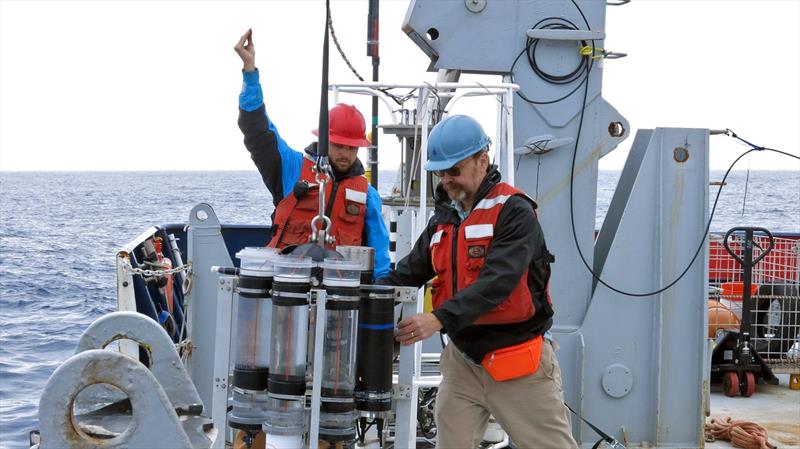
The ocean's 'biological pump' captures more carbon than expected
by Woods Hole Oceanographic Institution 9 Apr 2020 12:53 UTC

Marine chemist Ken Buesseler (right) deploys a sediment trap from the research vessel Roger Revelle during a 2018 expedition in the Gulf of Alaska. Buesseler's research focuses on how carbon moves through the ocean © Alyssa Santoro, Woods Hole Oceanographic Institution
Every spring in the Northern Hemisphere, the ocean surface erupts in a massive bloom of phytoplankton. Like plants, these single-celled floating organisms use photosynthesis to turn light into energy, consuming carbon dioxide and releasing oxygen in the process. When phytoplankton die or are eaten by zooplankton, the carbon-rich fragments sinks deeper into the ocean, where it is, in turn, eaten by other creatures or buried in sediments. This process is key to the "biological carbon pump," an important part of the global carbon cycle.
Scientists have long known that the ocean plays an essential role in capturing carbon from the atmosphere, but a new study from Woods Hole Oceanographic Institution (WHOI) shows that the efficiency of the ocean's "biological carbon pump" has been drastically underestimated, with implications for future climate assessments.
In a paper published April 6 in Proceedings of the National Academy of Sciences, WHOI geochemist Ken Buesseler and colleagues demonstrated that the depth of the sunlit area where photosynthesis occurs varies significantly throughout the ocean. This matters because the phytoplankton's ability to take up carbon depends on amount of sunlight that's able to penetrate the ocean's upper layer. By taking account of the depth of the euphotic, or sunlit zone, the authors found that about twice as much carbon sinks into the ocean per year than previously estimated.
The paper relies on previous studies of the carbon pump, including the authors' own. "If you look at the same data in a new way, you get a very different view of the ocean's role in processing carbon, hence its role in regulating climate," says Buesseler.
"Using the new metrics, we will be able to refine the models to not just tell us how the ocean looks today, but how it will look in the future," he adds. "Is the amount of carbon sinking in the ocean going up or down? That number affects the climate of the world we live in."
In the paper, Buesseler and his coauthors call on their fellow oceanographers to consider their data in context of the actual boundary of the euphotic zone.
"If we're going to call something a euphotic zone, we need to define that," he says. "So we're insisting on a more formal definition so that we can compare sites."
Rather than taking measurements at fixed depths, the authors used chlorophyll sensors —indicating the presence of phytoplankton— to rapidly assess the depth of the sunlit region. They also suggest using the signature from a naturally-occuring thorium isotope to estimate the rate at which carbon particles are sinking.
Buesseler is a principal investigator with WHOI's Ocean Twilight Zone project, which focuses on the little-understood but vastly important mid-ocean region. In a commentary published in Nature on March 31, Buesseler and colleagues call on the international marine research community to intensify their studies of the twilight zone during the upcoming United Nations Decade of the Ocean (2021-2030). Increased understanding of the twilight zone ecosystem and its role in regulating climate, the authors say, will lead to global policy to protect the area from exploitation.
Coauthors of the paper include: Phillip Boyd of University of Tasmania, Australia; Erin Black of Dalhousie University, Nova Scotia, and Lamont Doherty Earth Observatory, New York; and David Siegel, University of California, Santa Barbara.
This work was funded by: WHOI's Ocean Twilight Zone project; NASA as part of the EXport Processes in the global Ocean from RemoTe Sensing (EXPORTS) program; the Ocean Frontier Institute at Dalhousie University; and the Australian Research Council.
For more information, please visit www.whoi.edu.
This article has been provided by the courtesy of Woods Hole Oceanographic Institution.